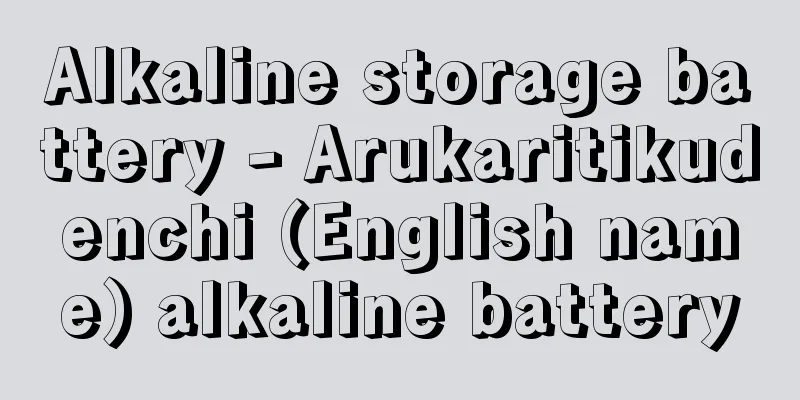Alkaline storage battery - Arukaritikudenchi (English name) alkaline battery

|
Alkaline batteries are a general term for batteries that use an alkaline aqueous solution of potassium hydroxide (KOH) or similar as the electrolyte, as opposed to acid batteries, such as lead-acid batteries. There are various types of batteries, such as nickel-cadmium batteries, nickel-metal hydride batteries, nickel-zinc batteries, Edison batteries, silver-zinc oxide batteries, silver-cadmium oxide batteries, metal-air batteries, and high-voltage nickel-metal hydride batteries. However, because nickel-cadmium batteries are the most representative of alkaline batteries, they are sometimes also called nickel-cadmium batteries. Alkaline aqueous solutions have low viscosity, so they have little resistance to ion movement and high conductivity. For example, the conductivity of a 30% potassium hydroxide aqueous solution is 5×10 -1 S/cm at room temperature, which is only slightly lower than the 7×10 -1 S/cm of the 35% sulfuric acid aqueous solution used in lead-acid batteries. It also has a conductivity about 50 times that of the organic electrolyte used in lithium-ion secondary batteries, and although it is inferior in battery voltage, it has excellent high-load discharge and high-speed charging characteristics. [Mitsuru Asano] Silver-zinc oxide batteryIt is an alkaline storage battery that uses divalent silver oxide (AgO) as the positive electrode active material, zinc (Zn) as the negative electrode active material, and KOH aqueous solution as the electrolyte, and is called a silver battery along with the silver oxide cadmium storage battery. It was invented in 1899 by Waldemar Jungner (1869-1924) of Sweden. The discharge reaction is shown below, and the discharge reaction of the zinc negative electrode is the same as that of a nickel-zinc battery, while the discharge reaction of the silver oxide positive electrode proceeds in two stages. (Zinc negative electrode) 2AgO+Zn+H 2 O―→Ag 2 O+Zn(OH) 2 The positive electrode is a sintered silver oxide plate with a porosity of approximately 60%, the negative electrode is a pasted zinc plate, the separator is cellophane, polyvinyl alcohol (PVA) film or polyethylene film, and the electrolyte is a 30-40% KOH aqueous solution. The voltage flatness is very good even with short-rate discharge. However, the low-temperature discharge characteristics are not good. Also, short-rate charging is not recommended, and good charging efficiency can be obtained by charging for 10 to 20 hours. Overcharging has a negative effect on the battery life. The charge/discharge cycle life is short. The energy density is 116Wh/kg for high-rate discharge and 123Wh/kg for low-rate discharge, the highest among alkaline storage batteries. Although expensive, these characteristics are used in space development, where light weight is required, such as rockets and artificial satellites, as well as in special power sources for deep-sea research vessels in the marine development field, underwater cameras, military torpedoes, missiles, etc. There is also the silver oxide battery, a primary battery that uses silver oxide for the positive electrode and zinc for the negative electrode, and button-type silver oxide batteries are used in electronic watches, cameras, calculators, electronic toys, electronic thermometers, etc. However, because they are expensive, they are losing market share to alkaline button batteries and button-type lithium batteries. [Mitsuru Asano] Silver Cadmium Oxide BatteryThis is an alkaline storage battery that uses a cadmium negative electrode instead of the zinc negative electrode of a silver-zinc oxide battery. The discharge reaction of the silver oxide positive electrode is the same as that of a silver-zinc oxide battery, and the discharge reaction of the cadmium negative electrode is the same as that of a nickel-cadmium battery. Therefore, the discharge reaction of the entire battery is shown as follows. 2AgO+Cd+H 2 O―→Ag 2 O+Cd(OH) 2 The battery structure is almost the same as the silver-zinc oxide battery, except for the use of cadmium negative plates, but it is easy to seal and can be made into a small cylindrical battery. Although its short-time rate discharge and low-temperature characteristics are inferior to those of the silver-zinc oxide battery, it is resistant to overcharging and has a long charge-discharge cycle life, which makes up for the shortcomings of the silver-zinc oxide battery. In addition, since it can be manufactured without using magnetic raw materials, it is used in scientific satellites, which require non-magnetic materials. [Mitsuru Asano] High-voltage nickel-metal hydride battery Unlike nickel-metal hydride batteries, which use hydrogen storage alloys for the negative electrode, this battery uses high-pressure hydrogen gas as the active material, and the negative electrode is a gas diffusion electrode made by binding carbon powder carrying platinum-based catalysts used in fuel cells with fluororesin. The power generation element itself, which is sandwiched between a separator impregnated with potassium hydroxide aqueous solution as an electrolyte, a nickel oxyhydroxide NiOOH positive electrode, and a H2 gas diffusion negative electrode, is housed in a pressure vessel that stores high-pressure H2 gas. The discharge reaction is (positive electrode) A major feature of this battery is its resistance to overcharging and overdischarging. When overcharging, oxygen gas generated from the positive electrode reacts with hydrogen gas at the negative electrode to form water, and even if hydrogen gas is generated from the positive electrode in an overdischarge state, it is oxidized and consumed at the gas diffusion electrode of the negative electrode, so the gas pressure inside the container does not rise above the specified level and become dangerous. Although it has the disadvantages that the electrolyte freezes at low temperatures below -10°C and that self-discharge increases at high temperatures, it is a lightweight and highly reliable storage battery if the temperature is controlled, and it is used as a power source for spacecraft such as artificial satellites. [Mitsuru Asano] "Ikeda Hironosuke, 'The Evolution of Batteries and Electronics - Thin, Small, High Performance' (1992, Industrial Research Institute)" ▽ "Japan Battery Co., Ltd., 'The Latest Practical Secondary Batteries: How to Select and Use Them' (1999, Nikkan Kogyo Shimbun)" ▽ "Okumi Zenpachi, 'Electrochemistry' (2000 , Ohmsha)" ▽ "Electrochemical Society, 'Electrochemistry Handbook' (2000, Maruzen)" ▽ "Battery Handbook Editorial Committee, 'Battery Handbook' (2001, Maruzen)" ▽ "Okumi Zenpachi and Ikeda Hironosuke, 'Secondary Battery Technology for Beginners' (2001, Industrial Research Institute)" [References] | | | | | |Source: Shogakukan Encyclopedia Nipponica About Encyclopedia Nipponica Information | Legend |
|
アルカリ蓄電池は鉛蓄電池に代表される酸蓄電池に対して、水酸化カリウムKOHなどのアルカリ性水溶液を電解質に使用する蓄電池の総称として名づけられている。これらにはニッケルカドミウム蓄電池、ニッケル水素蓄電池、ニッケル亜鉛電池、エジソン電池、酸化銀亜鉛蓄電池、酸化銀カドミウム蓄電池、金属空気電池および高圧形ニッケル水素蓄電池などの種類がある。しかし、ニッケルカドミウム蓄電池がアルカリ蓄電池の代表的なものであるので、ニッケルカドミウム蓄電池の別称としてよばれることもある。 アルカリ水溶液は粘度が小さいためイオンの移動に対する抵抗が少なく、導電率が大きい。たとえば、30%の水酸化カリウム水溶液の導電率は室温で5×10-1S/cmであり、鉛蓄電池に使用される35%硫酸水溶液の7×10-1S/cmにわずかに劣る程度である。またリチウムイオン二次電池に用いられている有機電解液の導電率の約50倍であり、電池電圧では劣るものの高負荷放電と高速充電特性に優れている。 [浅野 満] 酸化銀亜鉛蓄電池正極活物質に二価の酸化銀(AgO)、負極活物質に亜鉛(Zn)、そして電解液にKOH水溶液を用いたアルカリ蓄電池で、酸化銀カドミウム蓄電池とともに銀電池とよばれている。1899年にスウェーデンのユングナーWaldemar Jungner(1869―1924)によって発明された。放電反応は以下のように示され、亜鉛負極の放電反応はニッケル亜鉛電池と同じで、酸化銀正極の放電反応は2段に進む。 (亜鉛負極) 2AgO+Zn+H2O―→Ag2O+Zn(OH)2 正極には多孔率約60%の焼結式酸化銀極板が用いられ、負極にはペースト式亜鉛極板、セパレーターにはセロファン、ポリビニルアルコール(PVA)膜やポリエチレン膜、そして電解液は30~40%KOH水溶液が使用される。 短時間率放電においても電圧の平坦(へいたん)性はきわめてよい。しかし低温放電特性はよいとはいえない。また短時間率充電は好ましくなく、10~20時間充電すれば良好な充電効率が得られる。過充電は電池寿命に悪影響する。充放電サイクル寿命は短い。 エネルギー密度は高率放電用のもので116Wh/kg、また低率放電用では123Wh/kgで、アルカリ蓄電池のなかでは最高である。高価ではあるがその特性を生かして、軽量であることが求められるロケットや人工衛星などの宇宙開発の分野をはじめ、海洋開発分野の深海調査船、水中カメラ、軍用の魚雷、ミサイルなどの特殊電源に使用されている。 なお、正極に酸化銀、負極に亜鉛を用いる一次電池の酸化銀電池があり、ボタン形が電子式腕時計やカメラ、電卓、電子玩具、電子体温計などに用いられている。しかし高価であるため、アルカリボタン電池やボタン形リチウム電池などにシェアを奪われている。 [浅野 満] 酸化銀カドミウム蓄電池酸化銀亜鉛蓄電池の亜鉛負極のかわりにカドミウム負極を用いたアルカリ蓄電池である。酸化銀正極の放電反応は酸化銀亜鉛蓄電池と同じであり、またカドミウム負極の放電反応はニッケルカドミウム蓄電池と同じである。したがって電池全体の放電反応は以下のように示される。 2AgO+Cd+H2O―→Ag2O+Cd(OH)2 電池の構成はカドミウム負極板を使用することを除いて酸化銀亜鉛蓄電池とほとんど同じであるが、密閉化しやすく、円筒小形蓄電池とすることができる。短時間率放電と低温特性は酸化銀亜鉛蓄電池より劣るが、過充電に強く、充放電サイクル寿命が長いため、酸化銀亜鉛蓄電池の欠点を補い、また磁性のある原材料を使用することなく製作できるので、非磁性であることが必要な科学衛星に使用されている。 [浅野 満] 高圧形ニッケル水素蓄電池負極に水素吸蔵合金を使用するニッケル水素蓄電池と異なり、活物質には高圧水素ガスを用い、その負極には燃料電池に用いられる白金系触媒を担持した炭素粉末をフッ素樹脂で結着して作製したガス拡散電極を使用する。そして水酸化カリウム水溶液を電解液として含浸させたセパレーターをオキシ水酸化ニッケルNiOOH正極とH2ガス拡散負極で挟んだ発電素子自身を、高圧H2ガスを貯蔵する圧力容器内に収納した構造となっている。放電反応は この電池の大きな特徴は過充電、過放電に耐えられることである。過充電時に正極から発生する酸素ガスは負極で水素ガスと反応して水となり、また過放電状態になって正極から水素ガスが発生しても負極のガス拡散電極で酸化して消費されるので、容器内のガス圧が規定以上に上昇して危険な状態になることはない。マイナス10℃以下の低温では電解液が氷結し、また高温では自己放電が大きくなるという欠点があるが、温度制御をすれば軽量で信頼性の高い蓄電池であり、人工衛星などの宇宙機用電源に用いられている。 [浅野 満] 『池田宏之助著『電池の進化とエレクトロニクス――薄く・小さく・高性能』(1992・工業調査会)』▽『日本電池株式会社編『最新実用二次電池 その選び方と使い方』(1999・日刊工業新聞社)』▽『小久見善八編著『電気化学』(2000・オーム社)』▽『電気化学会編『電気化学便覧』(2000・丸善)』▽『電池便覧編集委員会編『電池便覧』(2001・丸善)』▽『小久見善八・池田宏之助編著『はじめての二次電池技術』(2001・工業調査会)』 [参照項目] | | | | | |出典 小学館 日本大百科全書(ニッポニカ)日本大百科全書(ニッポニカ)について 情報 | 凡例 |
<<: Alkali feldspar - Alkali feldspar
>>: Alkali cellulose - Arukariserurosu (English spelling)
Recommend
Hirado Chronicle - Heikoki
This is the diary of Taira Tsunetaka (1180-1255), ...
Neotrigonia
...Although many species live for a relatively lo...
Qibt (English spelling)
…Egyptian Christians who belong to the Coptic Chu...
Antiform
...These are called slump folds, or because they ...
Fernando Alvarado Tezozomoc
1530?-1610? A native historian from shortly after ...
Mount Paektu
A volcano straddling the border between North Kor...
Pancration
…Wrestling is said to be the oldest sport in the ...
In vivo method
…In Japan, there are stricter legal restrictions ...
North Korea
A socialist state founded on September 9, 1948 in...
King William's War
A war between Britain and France fought in the No...
Alchemilla japonica (alchemilla japonica)
A perennial plant of the Rosaceae family that rare...
Navigation light
A type of light equipped on an aircraft. It indic...
Squid breast - Squid breast
…Most formal shirts have separate collars that ca...
Matsumoto [town] - Matsumoto
A former town in Hioki District, central Satsuma P...
Achroite
...In addition, even in single colors, there are ...









